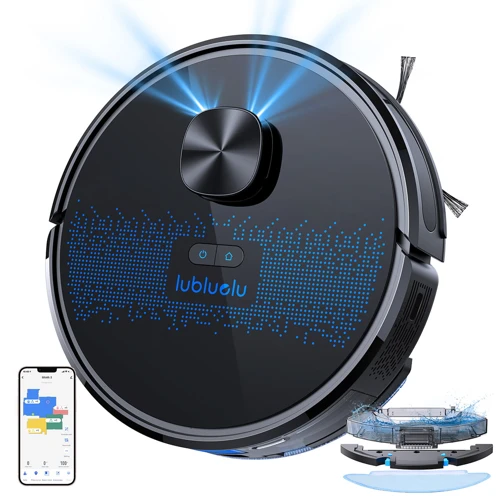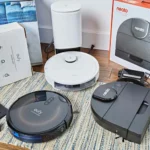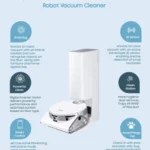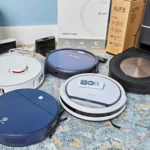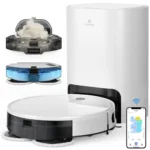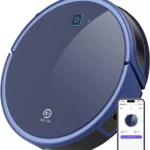Picture yourself coming home to a perfectly cleaned house without lifting a finger – sounds too good to be true, right? Well, it is now possible with the innovation of smart vacuum cleaners. But what really sets these cleaning appliances apart from traditional ones? The answer lies in their technology. Specifically, the use of virtual mapping and navigation has revolutionized the cleaning industry, making it easier and more efficient than ever before. In this article, we will detail the benefits of this technology and how it works, as well as compare it to traditional navigation to truly showcase the advantages of using virtual mapping and navigation. So, buckle up and get ready to dive into the future of cleaning!
Definition and basic concept
Virtual mapping and navigation is a technology that has revolutionized the operation and effectiveness of smart vacuum cleaners. This technology enables the smart vacuum cleaners to scan, detect and map out the layout of the house or room, using a combination of sensors, cameras, and complex algorithms.
The basic concept of this technology is to give the smart vacuum cleaner a clear understanding of its operating environment, by creating a virtual map of the room or the house. This map guides the smart vacuum cleaner to navigate through the room intelligently, enabling it to clean every part of the room effectively and efficiently, without bumping or crashing into walls, furniture, or any other obstacle.
Once the virtual map has been created, the smart vacuum cleaner uses it as a blueprint to commence cleaning. It moves around the room in a systematic manner, following the mapped out areas and avoiding obstacles on its way. The sensors and cameras on the smart vacuum cleaner provide real-time feedback to update the virtual map, ensuring the ongoing cleaning process is accurate and efficient.
This technology has enhanced the capability of smart vacuum cleaners, making them indispensable tools for cleaning homes and offices. In our next section, we will discuss the benefits of virtual mapping and navigation technology in smart vacuum cleaners.
For more information on virtual mapping and navigation in smart vacuum cleaners, you can check out virtual mapping and navigation in smart vacuums, top smart vacuum cleaners with mapping and navigation, how virtual mapping enhances smart vacuums, or smart home vacuum and mapping.
How Virtual Mapping and Navigation work
Virtual Mapping and Navigation technology allows smart vacuum cleaners to navigate through your home more efficiently than traditional navigation methods. This technology uses several advanced sensors, such as laser sensors, infrared sensors, and odometry sensors to create a detailed map of the environment.
Once the map is created, the smart vacuum cleaner uses this visual representation to identify the location of different objects and obstacles around your home. It then creates a cleaning path based on this information, which allows for more precise and efficient cleaning.
One of the most important features of Virtual Mapping and Navigation technology is its ability to adapt to changing environments. As the smart vacuum cleaner moves from room to room, it updates its map with new information and adjusts its cleaning path accordingly. This means it can avoid obstacles that may have been moved or detect new objects that were not present during the initial mapping process.
To navigate through your home, the smart vacuum cleaner uses a combination of sensors and algorithms to determine its location and orientation. It uses odometry sensors to measure the distance traveled, infrared sensors to detect obstacles, and laser sensors to measure the distance between objects.
Another important aspect of Virtual Mapping and Navigation technology is its ability to remember where it has already cleaned. This means that the smart vacuum cleaner can clean your entire home without missing any spots or wasting time cleaning areas it has already covered.
The advanced technology used in Virtual Mapping and Navigation allows smart vacuum cleaners to navigate through your home with precision, efficiency, and adaptability, making them an essential tool for anyone who wants to keep their home clean and dust-free.
Benefits of Virtual Mapping and Navigation in Smart Vacuum Cleaners

Virtual Mapping and Navigation is a revolutionary technology that has brought many benefits to the world of smart vacuum cleaners. With this cutting-edge technology, these cleaning devices are now able to navigate and clean your home with a level of precision and efficiency that was previously impossible. In this section, we will discuss some of the top benefits of Virtual Mapping and Navigation in Smart Vacuum Cleaners.
1. Precision cleaning
One of the most significant benefits of Virtual Mapping and Navigation in Smart Vacuum Cleaners is the ability to perform precision cleaning. This technology enables the cleaner to map out your home and create a systematic cleaning plan that ensures every inch of your home is covered. With this level of precision, you can be confident that your floors will be thoroughly cleaned without missing any spots.
2. Time efficiency
Smart vacuum cleaners with Virtual Mapping and Navigation significantly reduce the time it takes to clean your home. These devices are designed to clean in a systematic pattern, and they use sensors to detect and avoid obstacles, allowing them to move around your home seamlessly without getting stuck. The ability to create a cleaning plan saves time and ensures that the cleaner covers every area of your home quickly and efficiently.
3. Space optimization
Virtual Mapping and Navigation technology allows smart vacuum cleaners to optimize the space of your home by cleaning in a methodical pattern. This technology enables the cleaner to detect the layout of your home and create a cleaning plan that optimizes the space, ensuring that every room is cleaned without missing any spots.
4. Simplicity and convenience
Smart vacuum cleaners with Virtual Mapping and Navigation technology are incredibly easy to use. With just a few taps on your smart device, you can control the cleaner and set the cleaning schedule. This technology takes the hassle out of cleaning and makes it a more convenient and straightforward task.
Virtual Mapping and Navigation technology has brought significant benefits to the world of smart vacuum cleaners. With its precision cleaning, time efficiency, space optimization, simplicity, and convenience, it is no wonder that this technology has revolutionized the way we clean our homes. If you’re in the market for a new smart vacuum cleaner, be sure to look for one with Virtual Mapping and Navigation technology.
1. Precision cleaning
One of the biggest benefits of incorporating virtual mapping and navigation technology in smart vacuum cleaners is the precision cleaning it offers. Unlike traditional vacuum cleaners that rely on a random pattern to clean a room, smart vacuums equipped with virtual mapping and navigation technology use algorithms and sensors to create a precise map of the room they are cleaning.
Through the use of laser mapping and advanced algorithms, virtual mapping technology in smart vacuums ensures a thorough cleaning of every nook and cranny of a room, leaving no area untouched. The technology allows the vacuum to navigate around obstacles such as furniture, walls, and other obstacles with ease, ensuring that even hard-to-reach spaces and tight corners are cleaned effectively.
Virtual mapping and navigation technology also allows for spot cleaning. If there is a particularly dirty area or a spill, the smart vacuum cleaner can be directed to that spot for focused cleaning. This makes the cleaning process more efficient and effective than traditional vacuum cleaners that require the user to go back and forth to ensure a spot is cleaned.
Virtual mapping and navigation technology ensures that the vacuum cleaner does not miss any spots, as it is programmed to move in a methodical and deliberate manner. This means that the cleaner will clean every part of the room, whether it is a large open space or a cramped, cluttered one.
The precision cleaning provided by virtual mapping and navigation technology ensures that a room is cleaned to perfection, leaving it spotless and free from dirt and debris. This precision cleaning is particularly useful for people who suffer from allergies or respiratory problems, as it helps to eliminate dust and other allergens that can trigger an allergic reaction.
2. Time efficiency
Smart vacuum cleaners equipped with virtual mapping and navigation technology offer numerous benefits to homeowners, and one of the most prominent advantages is their ability to save time. With traditional vacuum cleaners, cleaning a space could take a significant amount of time, and even then, it might not be thoroughly cleaned. However, with the incorporation of virtual mapping technology, smart vacuum cleaners can clean a room efficiently and quickly, making cleaning a hassle-free process.
Smart Navigation Technology is the primary reason for time efficiency. By utilizing digital mapping and sensors, the vacuum cleaner can navigate through a room intelligently. It scans the room with optical sensors and creates a map of the area which helps it determine the most efficient path to take. This ensures the vacuum cleaner doesn’t clean the same area twice, and it doesn’t miss any areas.
Given that the vacuum cleaner has a map of the space, it knows the areas to avoid. For example, if there’s a sofa or a chair, the vacuum cleaner can recognize it and avoid it. This decreases the need for manual interference from the homeowner, ultimately leading to a more efficient cleaning process.
Auto-cleaning scheduling is another feature offered by smart vacuum cleaners, which contributes to saving time. Homeowners can program their smart vacuum cleaner to clean their home at particular intervals, ensuring that their home stays clean regularly. This is especially helpful for busy homeowners who don’t have time to clean their house frequently, as they can do it while they’re away from home.
Lastly, smart vacuum cleaners also save time by autonomously finding their dock stations and recharging themselves. Traditional vacuum cleaners require the user to be attentive and recharge the vacuum cleaner by themselves, consuming valuable time, but smart vacuum cleaners reduce that time by taking care of themselves.
All in all, virtual mapping and navigation technology have revolutionized the way we clean our homes. The time efficiency provided by smart vacuum cleaners translates to more time spent on other necessary tasks, and less time spent on repetitive, monotonous tasks like vacuuming.
3. Space optimization
Smart vacuum cleaners equipped with virtual mapping and navigation technology offer numerous benefits over traditional vacuum cleaners, and one of them is space optimization. Traditional vacuum cleaners may have difficulties navigating around objects such as furniture, resulting in missed spots or re-vacuuming already cleaned areas. However, with virtual mapping and navigation, smart vacuum cleaners can move around objects easily and clean every corner of a room with precision. This not only ensures that every spot in the room is cleaned, but it also prevents the vacuum cleaner from hitting or damaging objects that may obstruct its path.
One of the key features of virtual mapping and navigation technology in smart vacuum cleaners is the ability to create a virtual map of a room or space. Using sensors and cameras, the vacuum cleaner can scan the room and create a detailed map of the space that it needs to clean. This map is then used to optimize the vacuuming routine, ensuring that every inch of the room is covered without needlessly wasting time and energy cleaning already cleaned surfaces. This means that the vacuum cleaner can follow a specific cleaning pattern, which enables it to clean the space faster and more efficiently.
Another way that virtual mapping and navigation technology optimizes space is through the ability to identify the layout of the room and the position of furniture and other objects. With this knowledge, the smart vacuum cleaner can adjust its cleaning path accordingly, avoiding obstacles, redirecting its path as needed and cleaning right up to the baseboards without getting tangled up or stuck. This means that even in a cluttered room, the vacuum cleaner can move around and clean each area without moving and repositioning furniture.
Space optimization is a critical benefit of virtual mapping and navigation technology in smart vacuum cleaners, allowing them to navigate around rooms seamlessly and efficiently, contributing to a more thorough and timely cleaning experience. With virtual mapping and navigation technology, smart vacuum cleaners save time, energy, and ensure that the entire floor is cleaned thoroughly with every use.
4. Simplicity and convenience
Smart vacuum cleaners equipped with virtual mapping and navigation technology offer a high level of simplicity and convenience that traditional vacuum cleaners just can’t match. With the help of sensors and cameras, smart vacuum cleaners can effortlessly navigate through a room, cleaning up every spot and corner while avoiding obstacles along the way.
One of the biggest conveniences of these smart vacuum cleaners is their ability to operate autonomously. You can just set them up and let them do their job while you focus on other tasks. This means you can tackle other chores or even relax while the vacuum cleaner does its job. Additionally, their mapping and navigation systems make them capable of cleaning up a room without requiring any input from you at all.
Another great thing about smart vacuum cleaners is their ability to map and remember a room’s layout. Once a room is mapped, the vacuum cleaner can clean it systematically and efficiently, avoiding areas that don’t need cleaning and cleaning areas that need it multiple times. And the best part is that you don’t have to do any of this manually – the vacuum cleaner does it all for you.
Smart vacuum cleaners are also incredibly easy to use, with most models having intuitive and user-friendly controls. You don’t have to be a tech expert to operate them – just follow the simple instructions and you’re good to go. And, with the ability to link the vacuum cleaner to your smartphone or tablet, controlling your vacuum cleaner from your mobile device is even easier.
Finally, smart vacuum cleaners offer a level of convenience that traditional vacuum cleaners simply can’t match. They can be programmed to clean your home at specific times and even specific rooms. This means you can come home to a clean floor every day without lifting a finger.
The simplicity and convenience of smart vacuum cleaners equipped with virtual mapping and navigation technology make them an invaluable addition to any home. Their autonomous operation, mapping capabilities, ease of use, and overall convenience make them an essential tool for anyone looking to keep their home clean and tidy without any extra effort.
Virtual Mapping and Navigation Technology vs Traditional Navigation Technology
When it comes to smart vacuum cleaners, there are two types of navigation technologies used for guiding the device around a room: virtual mapping and traditional navigation. While traditional navigation technology relies on sensors and random movements to clean a room, virtual mapping technology takes things to the next level by creating a map of the space and calculating the most efficient cleaning path. Let’s take a closer look at each technology and compare their strengths and weaknesses.
Accuracy: One of the biggest advantages of virtual mapping technology is its accuracy. Traditional navigation relies on bump sensors and infrared sensors to determine obstacles, which can sometimes provide false readings. In contrast, virtual mapping technology uses sophisticated cameras and laser sensors to construct a precise map of each room. This allows the vacuum cleaner to accurately navigate around furniture, walls, and other obstacles, resulting in a more thorough and efficient clean.
Adaptability: While both technologies allow the vacuum to move around objects and avoid obstacles, virtual mapping technology is far more adaptable. By mapping the room, the device can learn the layout of the area and adjust its cleaning pattern accordingly. For example, if the vacuum cleaner detects a particularly dirty area, it can spend more time cleaning that spot before moving on. Traditional navigation, on the other hand, is more rigid, following a pre-programmed set of movements that may not be as effective.
Flexibility: Virtual mapping technology also offers more flexibility when it comes to scheduling cleaning times. Once the map of the room is created, the homeowner can program the device to clean specific areas at certain times. The vacuum cleaner will then be able to follow the exact schedule and provide a thorough clean without causing disruption. In comparison, traditional navigation technology does not allow for this level of customization and can disrupt a household if it happens to start cleaning at an inconvenient time.
Cost-effectiveness: Finally, virtual mapping technology may be more expensive than traditional navigation, but it can actually save money in the long run. By mapping the room and following the most efficient cleaning path, the vacuum cleaner is able to conserve battery life and use less power. Additionally, virtual mapping technology can provide a more thorough clean, reducing the need for repeat cleaning sessions.
While both virtual mapping and traditional navigation technologies have their pros and cons, virtual mapping technology appears to be the superior option for those who want a thorough and efficient clean. By creating a map of the room, using accurate sensors, and providing greater flexibility and adaptability, virtual mapping technology can make cleaning a breeze for any homeowner.
1. Accuracy
When it comes to navigation technology in vacuum cleaners, accuracy is one of the most important factors to consider. Traditional navigation technology relies on random movements or pre-determined patterns, which can lead to missed spots or repeated cleaning of the same area.
With virtual mapping and navigation technology, however, the accuracy of the cleaning process is significantly improved. The smart vacuum cleaner uses advanced sensors and cameras to create a detailed map of the cleaning area. This map is then analyzed and studied by the vacuum cleaner, which determines the most effective cleaning path to take.
The result is a precise and efficient cleaning process, with no missed spots or wasted time. Virtual mapping and navigation technology allows the vacuum cleaner to carefully maneuver around obstacles, furniture, and other objects in the room, ensuring a thorough and accurate cleaning.
Virtual mapping and navigation technology allows the vacuum cleaner to learn and adapt to its surroundings. Through its advanced mapping capabilities, the vacuum cleaner can identify areas that require more attention, and adjust its cleaning pattern accordingly. This means that the cleaning process gets more precise over time as the vacuum cleaner continues learning about its environment.
The accuracy of virtual mapping and navigation technology in smart vacuum cleaners is unparalleled. Its ability to map the cleaning area and adapt to the environment guarantees that every inch of the floor is cleaned thoroughly and efficiently.
2. Adaptability
When it comes to navigation in smart vacuum cleaners, adaptability is a crucial factor that sets virtual mapping and navigation technology apart from traditional navigation methods. Virtual mapping and navigation allows for the creation of a digital map of the space that the vacuum cleaner needs to clean. The cleaner then uses this map to navigate around obstacles and clean the entire area efficiently.
One of the key benefits of this technology is its ability to adapt to changes in the environment. Unlike traditional vacuum cleaners that use random patterns to clean a space, smart vacuum cleaners equipped with virtual mapping and navigation technology can adjust to changes in the layout of the space, such as the addition of new furniture or the removal of clutter.
This adaptability is especially important in homes or offices where the layout of the space is not static. For example, if you move furniture or change the layout of a room, a traditional vacuum cleaner would still follow its previous cleaning path and potentially miss new areas that need cleaning. However, with virtual mapping and navigation, the smart vacuum cleaner can easily update its internal map to account for the changes and adjust its cleaning pattern accordingly.
Virtual mapping and navigation technology allows smart vacuum cleaners to learn the layout of the space over time, improving their adaptability with each cleaning cycle. This means that the more the smart vacuum cleaner is used, the better it becomes at efficiently cleaning the space and avoiding obstacles.
Adaptability is a significant advantage of virtual mapping and navigation technology in smart vacuum cleaners. The ability of the cleaner to adapt to changing environments allows for more efficient and thorough cleaning, making it a popular choice for people who value convenience and quality.
3. Flexibility
When it comes to traditional navigation technology in vacuum cleaners, there’s little room for flexibility. These robots follow a predetermined path or a random direction to clean your floors, whereas Smart Vacuum Cleaners equipped with Virtual Mapping and Navigation Technology offer a level of flexibility that no other traditional vacuum cleaner can match.
With Virtual Mapping and Navigation Technology, the robot cleaner can adapt to any changes to the furniture and other obstacles within the house or apartment. Its flexible sensors can map out the entire floor and locate any objects without getting stuck in one location or waiting for the user’s response to it. This is because virtual mapping technology helps the robot analyze every corner of the room, giving it an idea of what’s where, irrespective of any changes that may arise.
New restrictions, additional furniture or a different layout, do not deter Smart Vacuum Cleaners equipped with Virtual Mapping and Navigation technology because they can instantly adapt to the new circumstances to create a new map of the room. The robot’s flexibility will come in handy if you plan to rearrange your furniture or if you are hosting a party at home, where more obstacles may come in the way of the robot’s cleaning process.
Thus, Smart Vacuum Cleaners equipped with Virtual Mapping and Navigation Technology are the way to go, especially if you want a floor cleaning solution that is flexible and hassle-free. They can adapt to your ever-changing floor plan, without any compromise on cleaning efficiency, which is a significant advantage over traditional vacuum cleaners that follow a set of predetermined patterns without the ability to adapt.
4. Cost-effectiveness
When it comes to purchasing a smart vacuum cleaner, cost is an important consideration for many customers. Virtual mapping and navigation technology has a reputation for being expensive, but it actually offers a high level of cost-effectiveness in the long run.
Firstly, virtual mapping and navigation technology allows the vacuum to clean more efficiently and accurately, reducing the amount of time and energy required to clean a space. This means that the vacuum can be run for shorter periods of time, resulting in lower electricity bills and reduced wear and tear on the machine. The targeted cleaning approach means that the vacuum consumes less power and produces less waste, resulting in more cost savings.
Secondly, virtual mapping and navigation technology allows for better maintenance and prolongs the lifespan of the vacuum cleaner. Because of the improved accuracy and efficiency of the navigation system, the vacuum is less likely to get stuck or damaged, reducing the need for repairs or replacement. This means that you’ll save more money in the long run by not having to constantly purchase new vacuum cleaners.
Thirdly, the technology allows the vacuum to adapt and change based on the needs of the user. Smart vacuums with virtual mapping and navigation technology can learn the cleaning habits of the owners and create a personalized cleaning plan, which saves money by avoiding unnecessary cleaning and conserving energy. Plus, it allows the user to easily schedule cleaning sessions to fit their routines, guaranteeing that the vacuum is only in use when needed.
While traditional vacuum cleaners may be cheaper to purchase initially, over time, smart vacuums with virtual mapping and navigation technology are a more cost-effective option. They offer efficient and targeted cleaning, prolong the lifespan of the machine and adapt to the user’s needs, which overall saves money in the long run.
Conclusion
After delving into the world of virtual mapping and navigation in smart vacuum cleaners, it is clear that this technology offers a host of benefits over traditional navigation methods. With precision cleaning, time efficiency, space optimization, simplicity, and convenience at the forefront of this technology, it’s no wonder why it has become increasingly popular amongst homeowners.
However, it’s important to note that virtual mapping and navigation technology is not without its downsides. While it offers a range of advantages over traditional navigation methods, it can be less accurate in some cases, may require additional maintenance, and comes with a higher price tag.
Despite these potential drawbacks, the benefits of virtual mapping and navigation technology are hard to ignore. As this technology continues to develop and improve, it’s likely we’ll see even more benefits emerge over time. With the ability to optimize cleaning schedules, improve home hygiene, and make our lives easier, it’s safe to say that virtual mapping and navigation technology in smart vacuum cleaners is here to stay.
In conclusion, when it comes to keeping our homes clean and tidy, virtual mapping and navigation technology is the way of the future. Whether you’re looking for a more efficient cleaning routine or simply want to take the hassle out of housework, this technology has something to offer for everyone. So why wait? Invest in a smart vacuum cleaner with virtual mapping and navigation technology today and experience the benefits for yourself.
Frequently Asked Questions
1. How does virtual mapping and navigation work in smart vacuum cleaners?
Virtual mapping and navigation technology in smart vacuum cleaners involves mapping out the rooms and areas of a home using various sensors and algorithms. The technology then creates a virtual map of the home, allowing the vacuum cleaner to navigate and clean using greater precision and efficiency.
2. Can virtual mapping and navigation technology clean corners and tight spaces?
Yes, virtual mapping and navigation technology can clean corners and tight spaces by using sensors and algorithms to detect these areas and navigate around them more effectively.
3. Are smart vacuum cleaners with virtual mapping and navigation more expensive than traditional vacuum cleaners?
Smart vacuum cleaners with virtual mapping and navigation technology are generally more expensive than traditional vacuum cleaners due to the advanced technology involved in their design.
4. Can virtual mapping and navigation technology help conserve energy?
Yes, virtual mapping and navigation technology can help conserve energy by allowing the vacuum cleaner to navigate and clean more efficiently, reducing the amount of time and energy needed to clean a home.
5. Do smart vacuum cleaners with virtual mapping and navigation require Wi-Fi to function?
Some smart vacuum cleaners with virtual mapping and navigation technology do require Wi-Fi to function, as they can be controlled and monitored using a smartphone app. However, there are also models that can function without Wi-Fi.
6. Can virtual mapping and navigation technology be used in commercial or industrial cleaning applications?
Yes, virtual mapping and navigation technology can be used in commercial and industrial cleaning applications to improve precision, efficiency, and overall effectiveness.
7. Can virtual mapping and navigation technology help reduce noise levels during cleaning?
Yes, virtual mapping and navigation technology can help reduce noise levels during cleaning by allowing the vacuum cleaner to navigate and clean more efficiently, reducing the amount of time and energy needed for cleaning.
8. Can smart vacuum cleaners with virtual mapping and navigation be programmed to clean at specific times?
Yes, many smart vacuum cleaners with virtual mapping and navigation technology can be programmed to clean at specific times, making it convenient for homeowners to have their homes cleaned even when they are not there.
9. Do smart vacuum cleaners with virtual mapping and navigation require regular maintenance?
Yes, like any mechanical device, smart vacuum cleaners with virtual mapping and navigation require regular maintenance to ensure optimal performance and longevity.
10. How does virtual mapping and navigation technology compare to traditional cleaning methods?
Virtual mapping and navigation technology is generally more efficient and precise than traditional cleaning methods, allowing for a more thorough and effective cleaning experience for homeowners.
